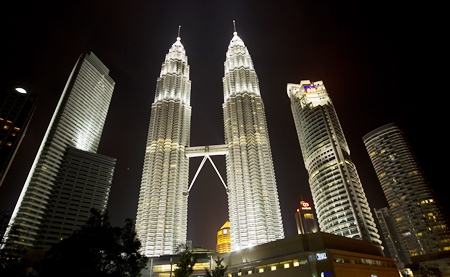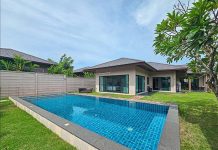Research analysts and property consultants have mixed views about developers that have been buying sizeable parcels of land recently, as the real estate market in Malaysia has slowed down and prices are relatively reasonable.
“It is a good time to acquire land when the market is slow. Some property developers may just be able to get a bargain price for their purchases,” said property consultancy CB Richard Ellis (M) Sdn Bhd executive director Paul Khong.
 Malaysia’s landmark Petronas Twin Towers are shown in the capital Kuala Lumpur. The nation’s major property developers have been buying up large land parcels despite signs of a cooling real estate sector. EPA/Ahmad Yusni
Malaysia’s landmark Petronas Twin Towers are shown in the capital Kuala Lumpur. The nation’s major property developers have been buying up large land parcels despite signs of a cooling real estate sector. EPA/Ahmad Yusni
Khong said that real estate sellers would also be more realistic concerning prices, as there were not too many buyers around.
He pointed out that the property sector was moving slowly back to a “buyer’s market” and the principle of “cash is king” would rule again.
In recent months, property developers such as Mah Sing Group Bhd, SP Setia Bhd, WCT Bhd and Hua Yang Bhd have been actively expanding their land bank, particularly in the Klang Valley area, which encompasses the nation’s capital Kuala Lupur and its environs.
Mah Sing last month announced that it was paying 333.26 million ringgit (US$105.93 million) or 18.55 ringgit per sq ft for 412 acres targeted for a mixed township near Bangi, Selangor.
SP Setia recently acquired 21.3 acres freehold land in Penang for 185.6 million ringgit ($58.99 million), and said this was for a mixed residential development project with a gross development value (GDV) of 1.1 billion ringgit ($349.64 million).
Meanwhile, WCT recently acquired two parcels of 468 acres and 57 acres in the Klang Valley.
WCT executive director Choe Kai Keong said that the land costing 450 million ringgit ($143.04 million) has a potential GDV of 5.2 billion ringgit ($1.65 billion).
The 468 acres in Rawang, Selangor would be developed into an integrated township with an estimated GDV of 1.2 billion ringgit ($381.43 million), while the 57-acre in Overseas Union Garden in Kuala Lumpur is planned for a mixed development worth 4 billion ringgit ($1.27 billion).
Hua Yang also has been acquiring small parcels of land in the Klang Valley since last year.
Hua Yang, which is known for developing residential properties in the affordable segment, recently agreed to pay 15.2 million ringgit ($4.83 million) for 21 acres of freehold land in Ipoh, Perak in the northeast of the country.
“Prices and sales of properties have obviously slowed down in 2012 as the number of buyers has been halved, with stricter bank lending guidelines. This is rather sensitive in the mid-high and high-end segments (such as above the RM3mil category) of the residential market,” said Khong.
Khong said property developers were now moving quickly to look at larger land banks to develop new projects, and were looking at cheaper locations where there was still demand from the mass market in the mid and lower-mid sections.
“Landed properties especially in the RM2mil and below categories should still do relatively well, as investors will still continue their quest but at a slightly lower segments.”
He also noted that the recent land sales were centered in secondary locations outside the city centre, but were in reasonably “good locations” and were in respect of big parcels where the developers could develop the “evergreen” landed segments again.
Khong pointed out that regardless of market conditions, property developers needed to take a long term view about their land bank.
“They have to continue to acquire land and develop, to sustain their operations and cover overhead costs.”
However, one property analyst said there were concerns that developers might be too aggressive in expanding their land bank.
“In good times, when the property market is hot, developers can increase their gearing without much worry as they can launch and sell properties quickly. Now, the market has cooled and they should be careful about increasing their gearing too much,” he said.
Maybank Investment Bank (IB) Research said in a recent report that it took a neutral view of SP Setia’s recent land buy in Penang.
“Despite its strategic location, the RM200 per sq ft land cost (in Penang) appeared to be on the high side. It is 33 per cent to 60 per cent higher than the 125 ringgit to 150 ringgit per sq ft asking on transacted prices in the area.”
However, Maybank IB noted that SP Setia’s net gearing was still very healthy, as this was expected to increase to 0.14 times post-acquisition of the Penang land (from 0.08 times as at January 2012).
Meanwhile, Kenanga Research said it took a neutral view of Mah Sing’s recent land buy near Bangi as the deal is expected to result in the company’s net gearing reaching 0.6 times (from the 0.3 times in the fourth quarter of 2011), based on an assumed 70:30 debt-equity financing.
“This has exceeded our comfort level of 0.5 times net gearing,” said the research unit.
However, Kenanga Research said Mah Sing’s expected net gearing of 0.6 times is manageable amd should fall below 0.5 times over the next two quarters, on the back of continuous billings.




